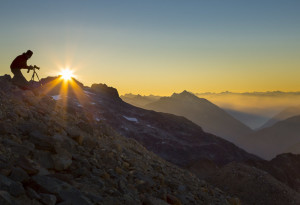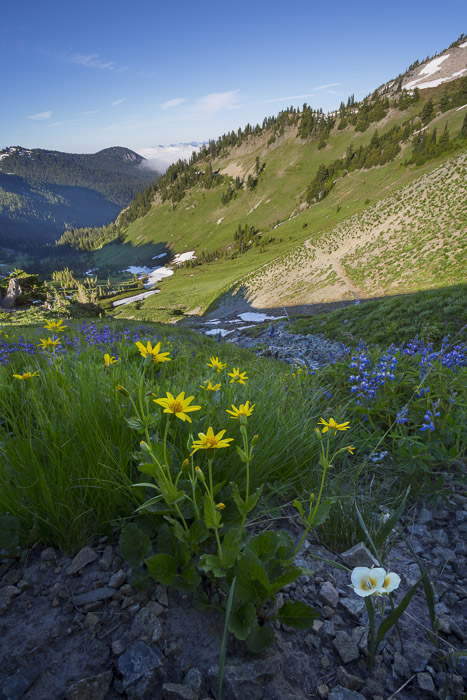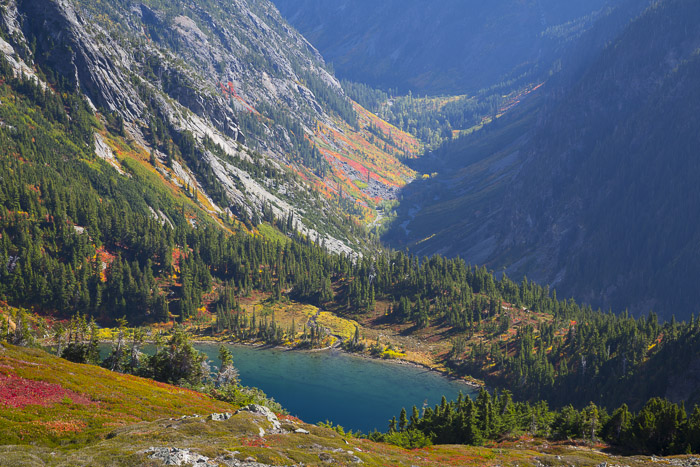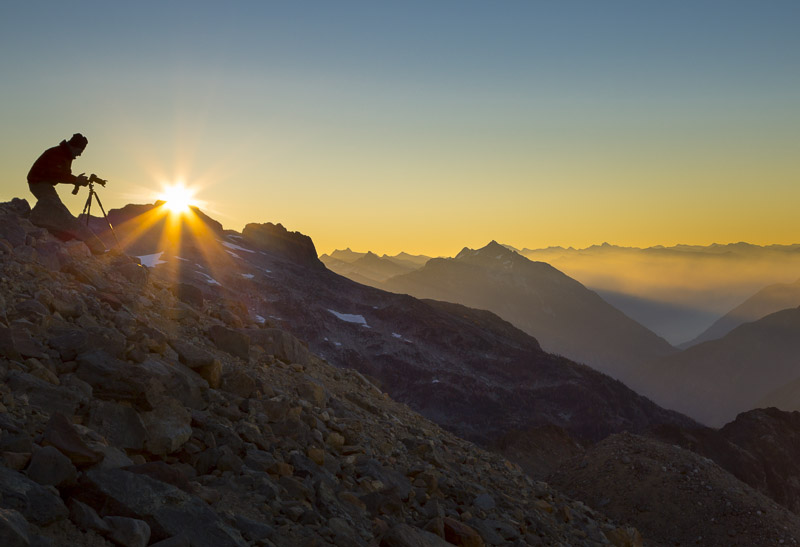

I’ve written thrice about backpacking (Ultralight Backpacking and Photography, Backpacking and Photography Re-visit, Light-Weight Backpacking and Photography), all pointed at ultra-lightening the backpack gear. The goal is to safely reduce pack weight to ease the burden of carrying a dSLR, lenses and tripod. And it works. Ultralight backpacking is a photographer’s godsend. Ultralighting gets us to the high country, then the dSLR produces uncompromised imagery. My backpack base load—that’s pack weight without the camera gear, food or water—is now at 11.4 lbs for three-season trips (∼ 30F). Take a look at what’s possible in Mike Clelland’s Ultralight Backpackin’ Tips, (Falcon Guides, 2011). The book is a treat. Clelland explains some of his ultralight strategies on line as well.
Below I discuss my backpack camera gear, starting with the dSLR, lens, sturdy tripod and ball head. Also required are the lighter-weight stuff, like camera case, polarizing filter and panorama tools, where you can save a bit on weight by careful selection of just what you need. Unfortunately, if you feel as I do that you need the dSLR, it’s little wonder the camera gear weight can match or exceed an ultralighter’s base weight. My camera gear totals 10.4 lbs for a two lens system; 8.9 lb if just one lens.
The dSLR is my choice for backpacking, with a system built around the relatively heavy (31 oz) Canon 5D Mark III. For Canon shooters, the new full-frame 6D saves about 6 oz and $1200, and could be all you need with no compromise in quality. Cropped-frame sensors like the latest Canon Rebel T4i (18MP, 20.8 oz), along with smaller lenses, are a slight compromise. Also a slight compromise—and considerably lighter—are the new mirrorless cameras, so named because they lack the bulky mirror and pentaprism/viewfinder of the SLR. The best offerings appear to match or even exceed the quality of the full-frame 5D introduced in 2005. Here’s a feature set to get a backpacking photographer in a lather: the Sony NEX7 w/18-200mm lens. The NEX7 has a C-size, 24MP sensor in a 10.3 oz body; the lens weighs 18.5 oz. Couple that with a Gitzo GT0531 tripod and Really Right Stuff BH-25 ball head, and you’ve got an almost uncompromising system the weighs under five lbs. Woo-hoo! Battery life for the NEX7 or other mirrorless cameras could be a downside, since you’d likely be framing shots using the LCD.
Lens
I like the f/4L series Canon lenses—no compromise on image quality and reasonable weight. My lightest backpack option is to carry just one lens, usually the 24-105mm f/4L (23.6 oz). If I need more range, I go with two lenses, the 17-40mm f/4L (16.8 oz) and the 70-200mm f/4L (29 oz).
Tripod
My Fiesol 3301 carbon tripod weighs 41.8 oz after I took off the leg padding, and stands 47” sans center column. It also has plenty of life left after seven years on the trail and on sea kayak trips. I looked at the 25.6 oz Gitzo GT0531, but it stands 42.1”, a bit of a compromise.
Ball Head
My Markin Q-ball weights 13.3 oz and is in fine shape after seven years use. Some light alternates to consider are the Feisol CB-30C (9.9 oz, $109) or Really Right Stuff BH-25 Pro (6.5 oz, $145), both of which use—like the Q-ball—a versatile, Arca-Swiss style, quick-release clamp.
Camera Case
I use a Tamrac 3330 Aero Zoom30 camera case (no shoulder strap, 7 oz), in which my 5D III with 17-40mm or 24-105mm f/4L lens just squeezes in. I slip the chest strap of my backpack through the Tamrac belt loop while hiking, so the camera is always right there in front of me for grab shots along the trail.

Filters
The one essential filter is a polarizer, to cut glare. I never carry skylight or UV filters. Less is more. I rely on lens caps and especially lens hoods to protect the glass. I also don’t carry split ND (neutral density) filters, archaic film mainstays that aren’t needed. Bracket exposures on a tripod instead, and combine them later in Photoshop for superior results (I know photographers have reasons for using them, but unless you can state the reason, and it makes sense, forget split ND’s). One other filter I sometimes carry is a full ND—I use a 6-stop—for slowing shutter speeds in bright light to produce that silky-smooth look in flowing water or in streaking clouds.
If I’m carrying a polarizing filter and an ND, I screw them together (both 77mm filter threads) for transport and put them in a single case. When I’m carry the two-lens kit, I may bring a 67-77mm step-up ring, cheaper and less weight then carrying a second (67mm) polarizer and ND.

Miscellaneous
Flash cards have such large capacity now a single extra will suffice. I carry a second camera battery (2.9 oz) for any trip over two nights, or for night shooting. I always carry a cable remote (Canon TC-80N3), for the most stable shutter release, bulb exposures and time intervals. I also always carry a wood panorama tool (2.7 oz), something I designed a few years ago to work with my particular ballhead/tripod.
I carry one clean, microfiber cleaning cloth. I don’t carry a hurricane blower or any sensor cleaners like a lens pen. It should be obvious, but we all need to clean lenses and check sensors at home before heading out.
My current camera kit with all associated weight is listed on my tools page.
Happy trails,
Gary
